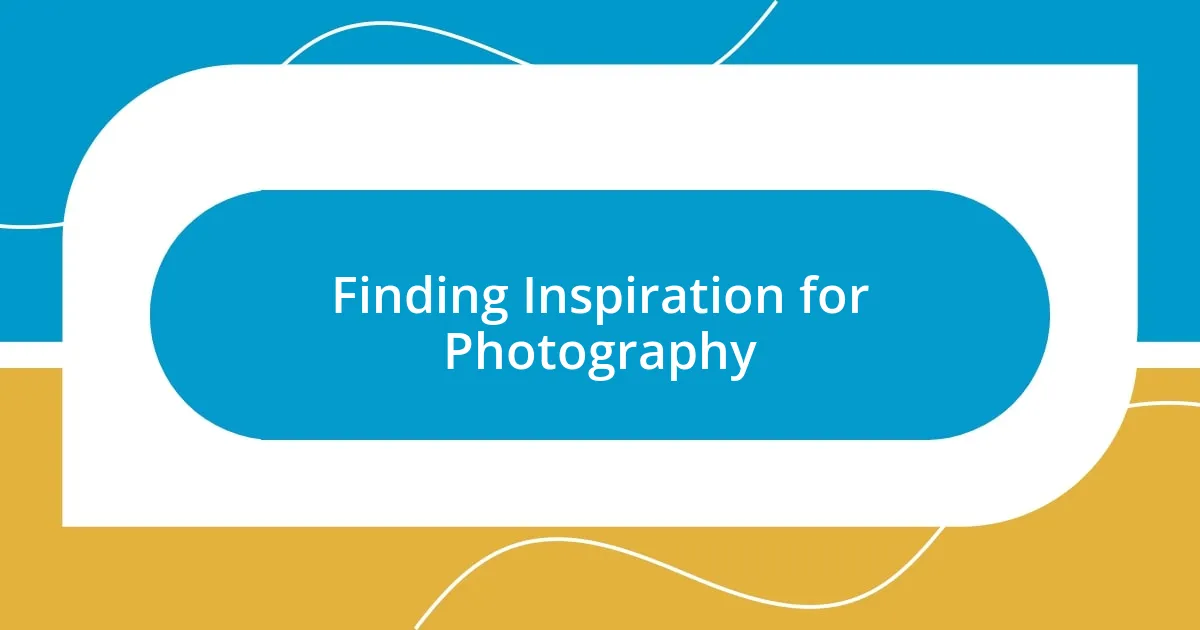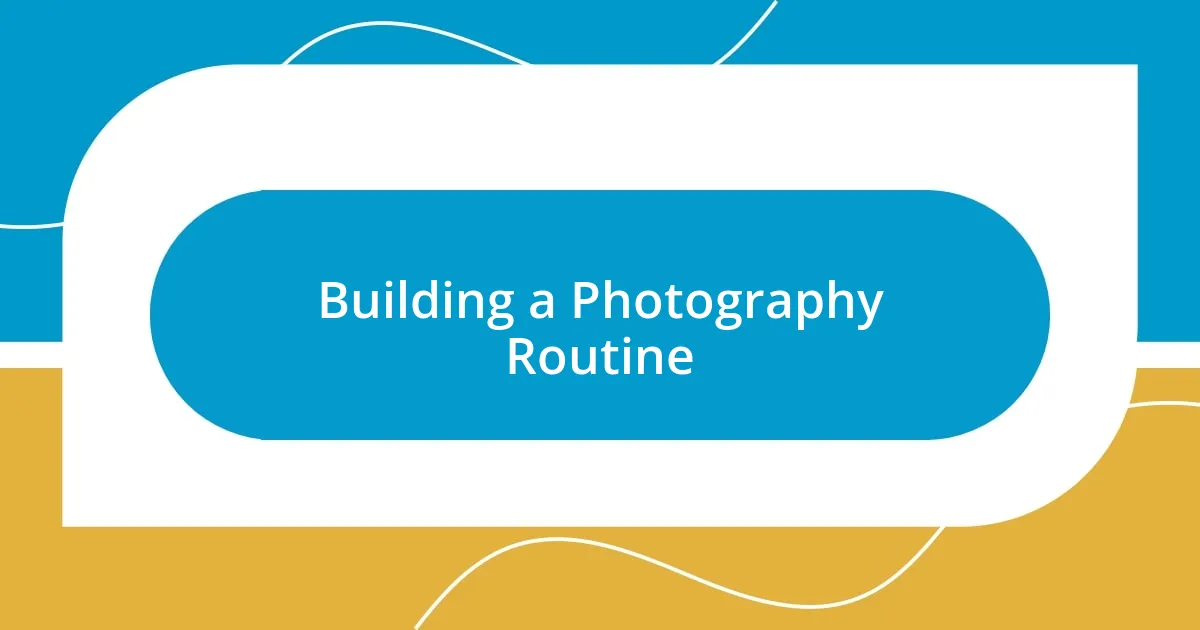Key takeaways:
- Personal photography challenges include perfectionism, self-doubt, and technical difficulties, which can hinder creativity and enjoyment.
- Common obstacles like lighting issues, lack of inspiration, and gear limitations require adaptability and thorough planning for successful shoots.
- Finding inspiration can come from daily surroundings, revisiting familiar locations, and engaging with other photographers to strengthen creativity.
- Building a photography routine and setting realistic goals helps maintain motivation and fosters continuous improvement in skills.

Understanding Personal Photography Challenges
Personal photography challenges can feel overwhelming at times, especially when you’re trying to capture the essence of a fleeting moment. I remember struggling to photograph a friend’s wedding; I was so focused on getting the perfect shot that I found myself missing the joy unfolding around me. Isn’t it interesting how the desire for perfection can sometimes blind us to the beauty right in front of us?
There’s also the challenge of self-doubt that many photographers face. I’ve had days when I’d scroll through social media, comparing my work to others, feeling inadequate in my abilities. Have you ever felt that nagging voice in your head questioning your talent? Recognizing that every photographer has their own unique journey can be a comforting perspective, helping to ease those insecurities.
Then, there’s the technical side of photography, which can be daunting. I vividly recall grappling with manual settings on my camera during a sunset shoot. The beautiful light was fading fast, and I was paralyzed by indecision over which settings to use. It made me realize that navigating these challenges is a part of the growth process. How do you handle those moments of technical confusion? Embracing these challenges can lead us to understand our equipment better and improve our skills over time.

Common Obstacles in Photography
Common obstacles in photography often arise unexpectedly. One that stands out for me is the issue of access to locations. I remember planning an extensive photoshoot at a breathtaking national park, only to find out that certain areas required special permits I didn’t have. It was disappointing, but it taught me a valuable lesson in planning. I now prioritize research before I head out, ensuring I know what to expect, which has significantly reduced that frustration.
Here are some typical challenges photographers encounter:
- Lighting issues: Finding the right light can be tricky, especially during golden hour.
- Lack of inspiration: Sometimes, the creativity just isn’t flowing.
- Gear limitations: Not everyone has access to high-end equipment; I often find myself working with what I have.
- Time constraints: Balancing photography with other life responsibilities can be tough.
- Weather conditions: Unpredictable weather can cancel planned shoots or affect the quality of images.
Navigating these obstacles means being adaptable as a photographer. I’ve learned the importance of flexibility and embracing the unexpected, but it’s not always easy.

Finding Inspiration for Photography
Finding inspiration for photography can sometimes seem elusive, but I’ve discovered that it often lies in the most unexpected places. One rainy afternoon, I decided to walk around my neighborhood with my camera, and what I found was an abundance of color and texture in the droplets clinging to leaves. It reminded me that looking closely at our everyday surroundings can spark creativity, even on mundane days. Have you ever turned a simple walk into a photography adventure?
As I delve into the world of photography, I’ve learned that inspiration often comes from revisiting my favorite spots. For instance, I frequently return to old locations that I’ve captured before, with new ideas swirling in my mind. Each visit reveals a fresh perspective, reminding me of how our viewpoints evolve over time. It’s fascinating how a different season or time of day can transform the same scene.
Another source of inspiration for me is engaging with other photographers, whether through online communities or casual meetups. Discussing techniques and sharing our work opens up doors to ideas that I may not have considered yet. Just last week, a fellow photographer shared a creative technique for shooting silhouettes that I found exciting. Interacting with others not only motivates me but also enriches my own photographic journey.
| Source of Inspiration | Examples |
|---|---|
| Nature Walks | Finding beautiful details in everyday scenery, like textures, light, and colors. |
| Revisiting Favorites | Returning to previous locations to explore them from a new angle or during a different time of year. |
| Community Engagement | Learning new techniques and gaining motivation from fellow photographers in discussions or workshops. |

Techniques to Overcome Creative Blocks
When I hit a creative block, I often turn to constraints as a source of innovation. For instance, one rainy week, I decided to limit myself to just using my phone camera and shooting in black and white. It was surprising how those restrictions sparked fresh ideas and pushed me to see things differently. Have you ever tried setting limits to break through a creative wall?
Another technique I love is simply taking a break from photography altogether. I remember feeling overwhelmed with my gear and ideas one summer, so I put my camera down for a few days and focused on other hobbies. That little detachment allowed my mind to clear and rejuvenated my creative energy. Sometimes, stepping back is just what you need to come back stronger.
Collaging images or ideas can also be incredibly helpful. I once gathered different prints from my previous shoots and mixed them together, creating a visual story of sorts. This not only reignited my passion but also allowed me to see connections between different themes and emotions in my work. Have you ever considered piecing together your past experiences in a visual format? It can be an enlightening process.

Setting Realistic Photography Goals
Setting realistic photography goals is crucial for nurturing your passion and avoiding burnout. I remember setting an ambitious goal to capture one stunning photo every day for a month. By the end of the first week, I felt overwhelmed and discouraged—not every day offered a perfect shot. Adjusting my goal to focus on one meaningful photo per week allowed me more time to experiment and truly engage with my subjects. When was the last time you felt your goals were too lofty?
I’ve also found value in breaking down larger objectives into smaller, achievable steps. Instead of aiming to master an entire photography genre, I now tackle one technique at a time. For example, I spent a month focusing solely on portrait photography, dedicating each session to exploring different lighting setups. This approach not only improved my skills but also kept my enthusiasm high. Wouldn’t you agree that small victories feel incredibly rewarding and keep you motivated?
Lastly, reflecting on my journey has helped me refine my goals. I often reassess what inspires me and what skills I want to develop. After a project left me feeling stuck, I took time to explore new themes, eventually leading me to delve into street photography. This growth mindset keeps my work fresh and aligned with my evolving interests. Have you taken the time to reflect on your photography goals recently? It can open new paths that reinvigorate your passion.

Building a Photography Routine
Building a consistent photography routine can significantly enhance your skills and keep your creativity flowing. One of my favorite techniques is designating specific days of the week for different types of photography. For instance, every Wednesday, I venture out for candid street shots, while weekends are reserved for nature photography. This way, I find myself looking forward to these dedicated sessions, and it creates a structure that encourages me to engage with my camera regularly. Do you have certain times or themes that motivate you to pick up your camera?
I’ve also realized that having a pre-shoot checklist can help streamline my process and spark excitement. Before each session, I jot down ideas, set up my gear, and even envision potential shots in my mind. I remember once preparing for a sunset shoot and felt a rush of anticipation just thinking about capturing the perfect light. This preparation not only calms my nerves but also heightens the entire experience. Have you tried planning out your shoots in detail? It can truly transform how you interact with your environment.
Finally, sharing my work regularly has become a part of my routine that keeps me accountable. I post my favorite shots online or share them with friends, which opens up dialogues about my progress and challenges. There’s something invigorating about receiving feedback and engaging with others who share your passion. It makes me wonder: what platforms or communities do you turn to for inspiration and motivation? Building a photography routine goes beyond technique; it’s about cultivating connections and celebrating your journey.

Reflecting on Your Photography Growth
Reflecting on your photography growth is an enlightening journey, and I find it helps to recognize the pivotal moments that led me to improve. I remember the first time someone complimented my work; it genuinely felt like a turning point. That simple praise ignited a passion in me to explore further, pushing my boundaries and leading to countless hours of practice. Have you ever experienced a moment that shifted your perspective on your own skills?
As I reflect, I often think back to my early days—a time when I felt stuck in a creative rut. I took a step back and reviewed my previous photographs. I noticed patterns in my composition and lighting that had potential but needed refining. It was like looking at a puzzle where only a few pieces were missing. This realization encouraged me to experiment with new styles and techniques that ultimately shaped my journey. How often do you take the time to review your past work and identify your growth areas?
Each photography session brings its own lessons, and in hindsight, the challenges have always been my best teachers. There was a frustrating day when I attempted night photography for the first time. I struggled with the settings and missed beautiful shots amidst my frustrations. Yet, reflecting on that experience later highlighted how much I learned about exposure and patience. In what ways do you think your toughest moments have shaped your growth in photography? Finding meaning in those difficulties can be incredibly rewarding and often leads to significant breakthroughs.














